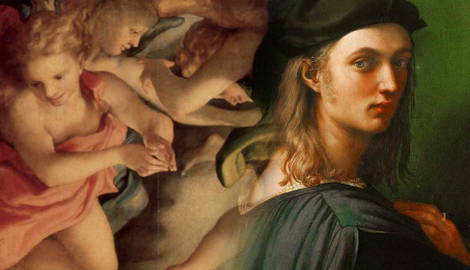
The art term sfumato (roughly translated as ‘gone up in smoke’, or ‘faded away’) refers to soft, smoky visual effects that blur the edges of people and objects, so they merge seamlessly with their surroundings. It was a popular technique that emerged during the Italian Renaissance period, and the term is most commonly used by art historians to refer to the art of this time period. One of the leading practitioners of sfumato was Leonardo da Vinci, who painted deliberately ‘without lines’ in order to create his enigmatic, atmospheric works of art. Another leader in sfumato painting was Giorgione, whose brooding artworks show figures that seem to blend in with the space around them.
1. Leonardo da Vinci, Mona Lisa, 1503

No discussion on the sfumato would be complete without a reference to the Florentine Renaissance painter Leonardo da Vinci, the pioneer who first made use of this smoky, atmospheric technique. While he made use of the sfumato technique in almost all of his best-known works of art, the Mona Lisa, painted in 1503, is one of the finest examples, showcasing the artist’s mastery of soft, hazy effects and the complete blurring of outlines and edges. We see Da Vinci’s sfumato most clearly at play in her skin, as light and shadow are carefully modelled across her face and hands to give her both sculptural depth and an enigmatic, mysterious quality.
2. Giorgione, Portrait of a Young Man, 1504

The Florentine Renaissance painter Giorgione was a contemporary of Da Vinci, and he also adopted a similar sfumato style, delicately blending tones together to create the effect of soft, hazy light, along with chiaroscuro effects. In Portrait of a Young Man, 1504, Giorgione depicts a young male sitter with great sensitivity, observing his quiet, contemplative expression with care. We see in this artwork how Giorgione paints the subtle modulation of tones across the young man’s face, and how his skin merges with his thick, dark brown hair. In the background, light falls across one half of the painting, descending into complete black on the left.
3. Antonio da Correggio, Nativity (The Holy Night), 1529-30

High Renaissance master Antonio da Correggio was another practitioner of sfumato, weaving it into a wide variety of subjects. Throughout the 16th century Correggio developed a strong reputation for creating the most magical, atmospheric light effects by employing an increasingly complex language of sfumato. In Nativity (also known as The Holy Night, or La Notte), 1529-30, we see Correggio at his finest, capturing the glowing aura of light emanating from Mary and Jesus in the center, while the light gradually blends outwards into the intimate scene of adoring shepherds and angels beyond, whose bodies in turn blend with the darkened shadows of night beyond.
4. Raphael, Portrait of Bindo Altoviti, 1515

Italian Renaissance painter Raphael was another fan of the sfumato technique. In contrast with other Renaissance sfumato artists, Raphael’s work was clearer and brighter, with brilliant flashes of vivid color. However, we often see in the hands and faces of his subjects subtle, soft gradations of light into dark, in order to capture the rounded, undulating forms of human skin. In his Portrait of Bindo Altoviti, 1515, Raphael paints a young man with head in three-quarter view, caught as if unaware looking over one shoulder.
In this softly lit painting Raphael pays special attention to the lighting effects coming in from the left, observing how it catches highlighted areas o the young man’s face, and falls gradually into areas of soft grey shadow around hi eye socket and under his chin. Much like many sfumato painters, Raphael conveys an air of ease, tranquility and quiet mystery with these soft, carefully blended lighting effects.










